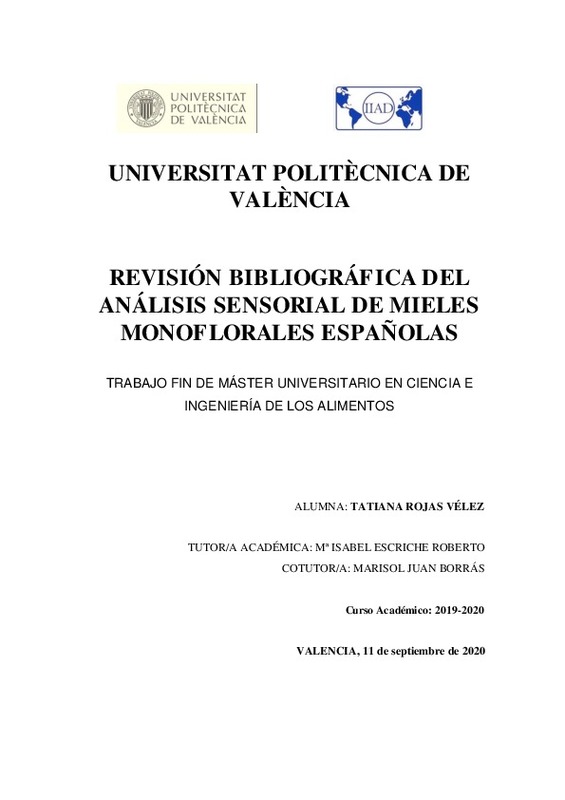JavaScript is disabled for your browser. Some features of this site may not work without it.
Buscar en RiuNet
Listar
Mi cuenta
Estadísticas
Ayuda RiuNet
Admin. UPV
Revisión bibliográfica del análisis sensorial de mieles monoflorales españolas
Mostrar el registro sencillo del ítem
Ficheros en el ítem
| dc.contributor.advisor | Escriche Roberto, Mª Isabel
|
es_ES |
| dc.contributor.advisor | Juan Borrás, María del Sol
|
es_ES |
| dc.contributor.author | Rojas Vélez, Tatiana
|
es_ES |
| dc.date.accessioned | 2020-10-13T12:09:38Z | |
| dc.date.available | 2020-10-13T12:09:38Z | |
| dc.date.created | 2020-09-24 | |
| dc.date.issued | 2020-10-13 | es_ES |
| dc.identifier.uri | http://hdl.handle.net/10251/151578 | |
| dc.description.abstract | [EN] Sensory analysis is a useful analytical technique to classify monofloral honeys (orange blossom, rosemary, thyme, etc.) since it allows defining their organoleptic profile. To do this, it is necessary to identify and quantify the sensory attributes that characterize them and build specific organoleptic profiles. In this sense, the main objective of the present work has been to carry out a review of the published information on the methods most used in the sensorial characterization of honey, with special attention to Spanish monofloral honeys and the attributes that define them. In general, in recent years both classic descriptive methods that require trained panelists (Quantitative descriptive analysis "QDA" or qualitative descriptive sensory analysis), and modern methods (Free Choice Profiling (FCP), Check -all-that-apply “CATA” or Flash Profiling “FP”). Even though the latter have the advantage of being more flexible and saving time since they especially use habitual consumers of the product, the most used method for the characterization of honeys continues to be the classic QDA. Commonly, the attributes selected to describe honeys are: visual or appearance, aroma, flavour and texture. Among the statistical tools most used in data processing, the analysis of variance (ANOVA) stands out, together with a multiple comparison test (Duncan's Test or Tukey's HSD Test), both useful to differentiate between individual samples for each sensory attribute. The Principal Component Analysis (PCA) also stands out (it allows visualizing the relationships between honeys and sensory attributes), as well as the Generalized Procrustes Analysis (GPA), because it provides a consensual image of the data of each panelist in a two-dimensional or three-dimensional space. | es_ES |
| dc.description.abstract | [ES] El análisis sensorial es una técnica analítica útil para clasificar las mieles monoflorales (azahar, romero, tomillo, etc.), ya que permite definir su perfil organoléptico. Para ello, es necesario identificar y cuantificar los atributos sensoriales que las caracterizan y construir perfiles organolépticos específicos. En este sentido, el objetivo principal del presente trabajo es realizar una revisión de la información publicada sobre los métodos más empleados en la caracterización sensorial de la miel, con especial atención a las mieles monoflorales españolas y a los atributos que las definen. En general, en los últimos años se han utilizado métodos clásicos descriptivos que requieren de panelistas entrenados [Quantitative descriptive analysis (QDA) or Qualitative Descriptive Sensory Analysis] y, métodos modernos [Free Choice Profiling (FCP), Check‐all‐that‐apply (CATA) or Flash Profiling (FP)]. A pesar de que estos últimos presentan la ventaja de ser más flexibles y ahorrar tiempo ya que usan especialmente consumidores habituales del producto, el método más usado para la caracterización de mieles sigue siendo el QDA. En general, los atributos seleccionados para describir las mieles son visuales o de apariencia, de aroma, de sabor y de textura. Entre las herramientas estadísticas más empleadas para el tratamiento de datos destaca el análisis de varianza (ANOVA), junto con una prueba de comparación múltiple (Test de Duncan o Test HSD de Tukey), ambas útiles para diferenciar entre muestras individuales para cada atributo sensorial. También destacan el Análisis de Componentes Principales (PCA) (permite visualizar las relaciones entre las mieles y los atributos sensoriales), así como el Análisis Generalizado de Procrustes (GPA), debido a que proporciona una imagen consensuada de los datos de cada panelista individual en un espacio bidimensional o tridimensional. | es_ES |
| dc.format.extent | 25 | es_ES |
| dc.language | Español | es_ES |
| dc.publisher | Universitat Politècnica de València | es_ES |
| dc.rights | Reconocimiento - No comercial (by-nc) | es_ES |
| dc.subject | Miel monofloral | es_ES |
| dc.subject | Evaluación sensorial | es_ES |
| dc.subject | Propiedades sensoriales | es_ES |
| dc.subject | Monofloral honey | es_ES |
| dc.subject | Sensory evaluation | es_ES |
| dc.subject | Sensory properties | es_ES |
| dc.subject.classification | TECNOLOGIA DE ALIMENTOS | es_ES |
| dc.subject.other | Máster Universitario en Ciencia e Ingeniería de los Alimentos-Màster Universitari en Ciència i Enginyeria Dels Aliments | es_ES |
| dc.title | Revisión bibliográfica del análisis sensorial de mieles monoflorales españolas | es_ES |
| dc.type | Tesis de máster | es_ES |
| dc.rights.accessRights | Abierto | es_ES |
| dc.contributor.affiliation | Universitat Politècnica de València. Departamento de Tecnología de Alimentos - Departament de Tecnologia d'Aliments | es_ES |
| dc.contributor.affiliation | Universitat Politècnica de València. Escuela Técnica Superior de Ingeniería Agronómica y del Medio Natural - Escola Tècnica Superior d'Enginyeria Agronòmica i del Medi Natural | es_ES |
| dc.description.bibliographicCitation | Rojas Vélez, T. (2020). Revisión bibliográfica del análisis sensorial de mieles monoflorales españolas. http://hdl.handle.net/10251/151578 | es_ES |
| dc.description.accrualMethod | TFGM | es_ES |
| dc.relation.pasarela | TFGM\116551 | es_ES |
Este ítem aparece en la(s) siguiente(s) colección(ones)
-
ETSIAMN - Trabajos académicos [3541]
Escuela Técnica Superior de Ingeniería Agronómica y del Medio Natural






